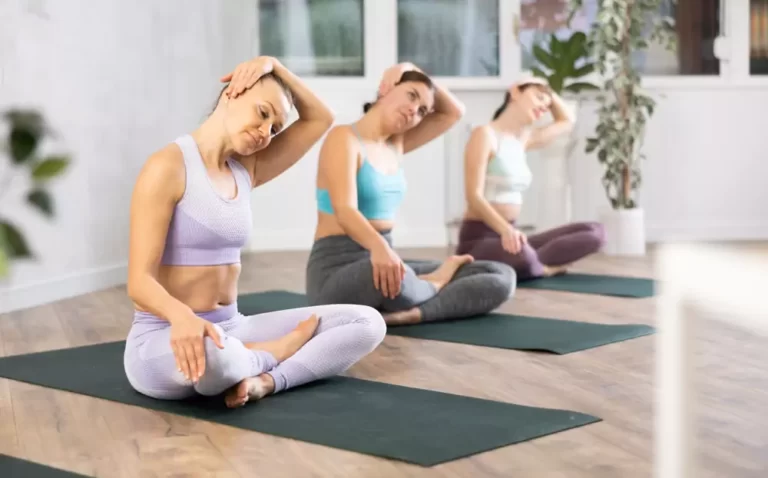Does Yoga Boost Collagen Production in the Body?

Yoga is a popular form of exercise that is renowned for its physical and mental benefits. But does it also help to build collagen? Collagen is an essential component of the skin, helping to keep it supple, smooth and youthful looking.
We’ll see how yoga can help to boost collagen production and provide you with advice on how to get the most out of your practice.
Yoga has long been used as a way to improve overall health and wellbeing, but did you know that regular yoga practice can help you to build more collagen? With regular practice, you can maintain or even increase your natural collagen levels, which will result in healthier skin.
So if you’re looking for ways to keep your skin looking younger for longer, yoga could be the answer.
What is Collagen?
Collagen is the most abundant protein in our bodies, making up around one-third of our total protein content. It is a structural protein that provides strength and elasticity to our connective tissues, such as skin, bones, tendons, and cartilage. Collagen is responsible for maintaining the integrity of our tissues and organs and is essential for wound healing, bone health, and skin elasticity.
There are several types of collagen, with type I being the most abundant and found in skin, bones, and tendons. Type II is found in cartilage, while type III is found in blood vessels and organs. Other types of collagen include type IV, which is found in the basement membrane of epithelial tissues, and type V, which is found in the placenta.
Yoga and Collagen Production
Yoga is a mind-body practice that combines physical postures, breathing techniques, and meditation to promote physical and mental well-being. Practicing yoga has been shown to have numerous health benefits, including reducing stress, improving flexibility and balance, and promoting relaxation.
Studies have also shown that yoga may stimulate collagen production, particularly in the skin. In a 2015 study, researchers found that practicing facial yoga for 20 weeks increased skin elasticity and reduced wrinkles in middle-aged women. The study suggested that facial yoga may stimulate collagen production, leading to improved skin elasticity and reduced signs of aging.
Yoga poses that may stimulate collagen production include:
- Downward facing dog: This pose stretches the hamstrings and calves, promoting blood flow to the skin and stimulating collagen production.
- Cobra pose: This pose stretches the chest and shoulders, promoting blood flow to the skin and stimulating collagen production.
- Fish pose: This pose stretches the neck and throat, promoting blood flow to the face and stimulating collagen production.
- Shoulder Stand (Sarvangasana): This pose involves lifting the legs and hips up towards the ceiling while supporting the back with the hands. It is believed to increase blood flow to the face and neck, which may help improve skin health and collagen production.
- Plow Pose (Halasana): This pose involves bringing the legs over the head and touching the toes to the ground behind the head. It is thought to help improve circulation and stimulate the thyroid gland, which may help support collagen production.
- Camel Pose (Ustrasana): This pose involves arching the back and reaching the hands back towards the feet. It is believed to help stretch and strengthen the neck and spine, which may help improve posture and support collagen production.
Pranayama
Pranayama is the practice of controlling one’s breath and its rhythms to achieve physical, mental, and spiritual wellness. It promotes deep breathing, which sends more oxygen to the body’s cells and increases circulation.
This can help in building collagen by:
- Enhancing the production of elastin and collagen proteins due to increased oxygenation
- Strengthening facial muscles that support the skin’s structure
- Stimulating blood flow to create an environment conducive to healthy cell growth
- Rejuvenating skin by improving cell function and tone
- Relaxing the mind and body, reducing stress levels which are known to cause premature wrinkling.
Through Pranayama, practitioners can establish a better connection with their body. By doing so, they can become aware of what it needs for improved health and wellbeing.
This awareness will help them take proactive steps towards building collagen naturally.
Other Ways to Boost Collagen Production
Dietary Changes
Eating a balanced diet full of nutrients that support collagen production can help improve skin health. Some foods that are high in collagen-boosting nutrients include:
- Fruits and vegetables high in vitamin C, such as oranges, strawberries, bell peppers, and broccoli
- Protein-rich foods, such as lean meats, fish, beans, and lentils
- Foods high in zinc and copper, such as oysters, nuts, and seeds
It is also important to stay hydrated by drinking plenty of water and limiting alcohol and caffeine intake, which can dehydrate the skin and lead to collagen breakdown.
Skincare
Using skincare products that contain collagen-boosting ingredients can help improve skin elasticity and reduce the appearance of fine lines and wrinkles. Some ingredients to look for include:
- Retinoids, which can increase collagen production and improve skin texture
- Vitamin C, which can help protect the skin from free radical damage and stimulate collagen synthesis
- Peptides, which can help promote collagen production and improve skin firmness
In addition to using collagen-boosting products, it is important to protect the skin from sun damage by wearing sunscreen and avoiding prolonged sun exposure.
Lifestyle Changes
Lifestyle factors can also impact collagen production. Some ways to support collagen synthesis include:
- Getting enough sleep, as lack of sleep can lead to collagen breakdown
- Reducing stress, as stress can lead to inflammation and collagen breakdown
- Exercising regularly, as exercise can help stimulate collagen production and improve skin elasticity
It is also important to avoid smoking, which can lead to premature aging and collagen breakdown.
Exercise and Lifestyle Factors
Exercise and other lifestyle factors can also impact collagen production. Here are some tips:
- Resistance training: Strength training exercises can stimulate collagen synthesis in the muscles and connective tissues.
- Sun protection: UV rays can damage collagen and lead to premature aging. Protect your skin from the sun by wearing sunscreen, a hat, and seeking shade.
- Quit smoking: Smoking has been shown to decrease collagen production and damage skin cells, leading to premature aging.
- Hydrate: Drinking plenty of water can help maintain skin elasticity and promote collagen synthesis.
The Role of Yoga in Overall Health and Wellness
While yoga may stimulate collagen production, it also has numerous other health benefits. Practicing yoga can improve flexibility, strength, balance, and reduce stress and anxiety. It can also promote mindfulness and self-awareness and lead to a greater sense of well-being.
Yoga can be practiced by people of all ages and fitness levels, making it a versatile and accessible form of exercise. There are many different types of yoga, from gentle, restorative yoga to more challenging styles like power yoga.
Integrating yoga into a holistic health and wellness routine can have numerous benefits. Pairing yoga with healthy nutrition, skincare, and lifestyle habits can help maintain healthy connective tissues, reduce stress and anxiety, and promote overall physical and mental well-being.
FAQ’s
Does yoga help with collagen production?
There is some evidence to suggest that yoga can stimulate collagen production. Certain yoga poses, such as downward-facing dog and child’s pose, can promote blood flow and oxygenation to the skin, which can stimulate collagen synthesis.
How long does it take to see results from yoga for collagen production?
The time it takes to see results from yoga for collagen production can vary depending on the individual and the frequency and intensity of their yoga practice. Some people may notice a difference in skin texture and tone within a few weeks, while others may take longer to see results.
Are there any risks associated with yoga for collagen production?
While yoga is generally safe for most people, it is important to consult with a healthcare provider before beginning any new exercise program, particularly if you have a pre-existing medical condition. Certain yoga poses may not be suitable for everyone, and modifications may be necessary to prevent injury.
Can other lifestyle factors impact collagen production?
Yes, other lifestyle factors can impact collagen production, including sun exposure, smoking, and hydration. Protecting your skin from the sun, quitting smoking, and drinking plenty of water can all help promote healthy collagen synthesis.
Are there any foods that can help boost collagen production?
Yes, certain foods can help boost collagen production, including those high in vitamin C, such as citrus fruits and berries, as well as those containing collagen-building amino acids, such as seafood.
Conclusion
Collagen is an essential protein that plays a vital role in maintaining healthy connective tissues. While collagen production naturally declines with age, there are ways to boost collagen synthesis and maintain healthy connective tissues. Practicing yoga, eating a healthy diet, using skincare and beauty treatments, and incorporating healthy lifestyle habits can all promote collagen synthesis and overall well-being.
Yoga, in particular, has been shown to have numerous health benefits, including stimulating collagen production in the skin. By incorporating yoga into a holistic health and wellness routine, individuals can improve their physical and mental health, maintain healthy connective tissues, and promote overall well-being.





